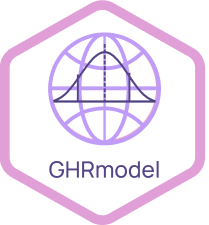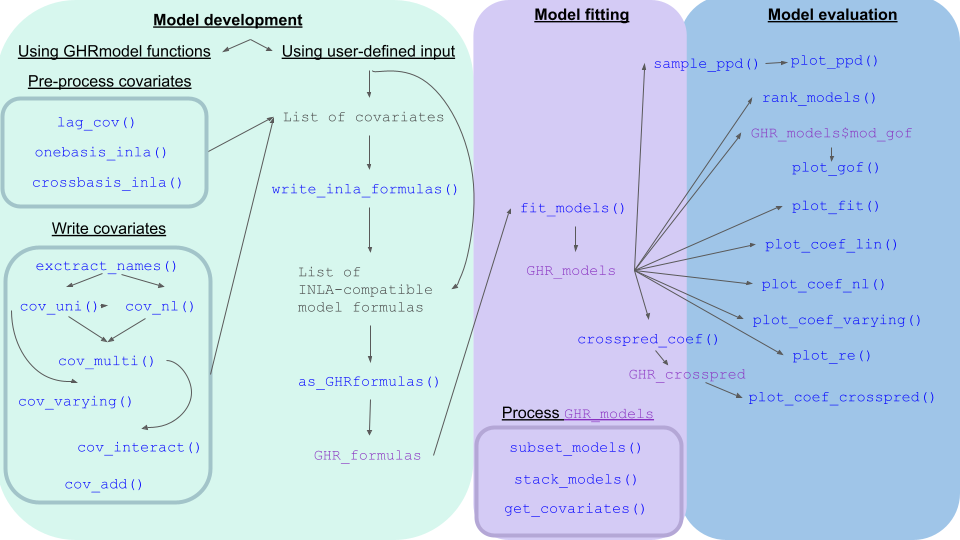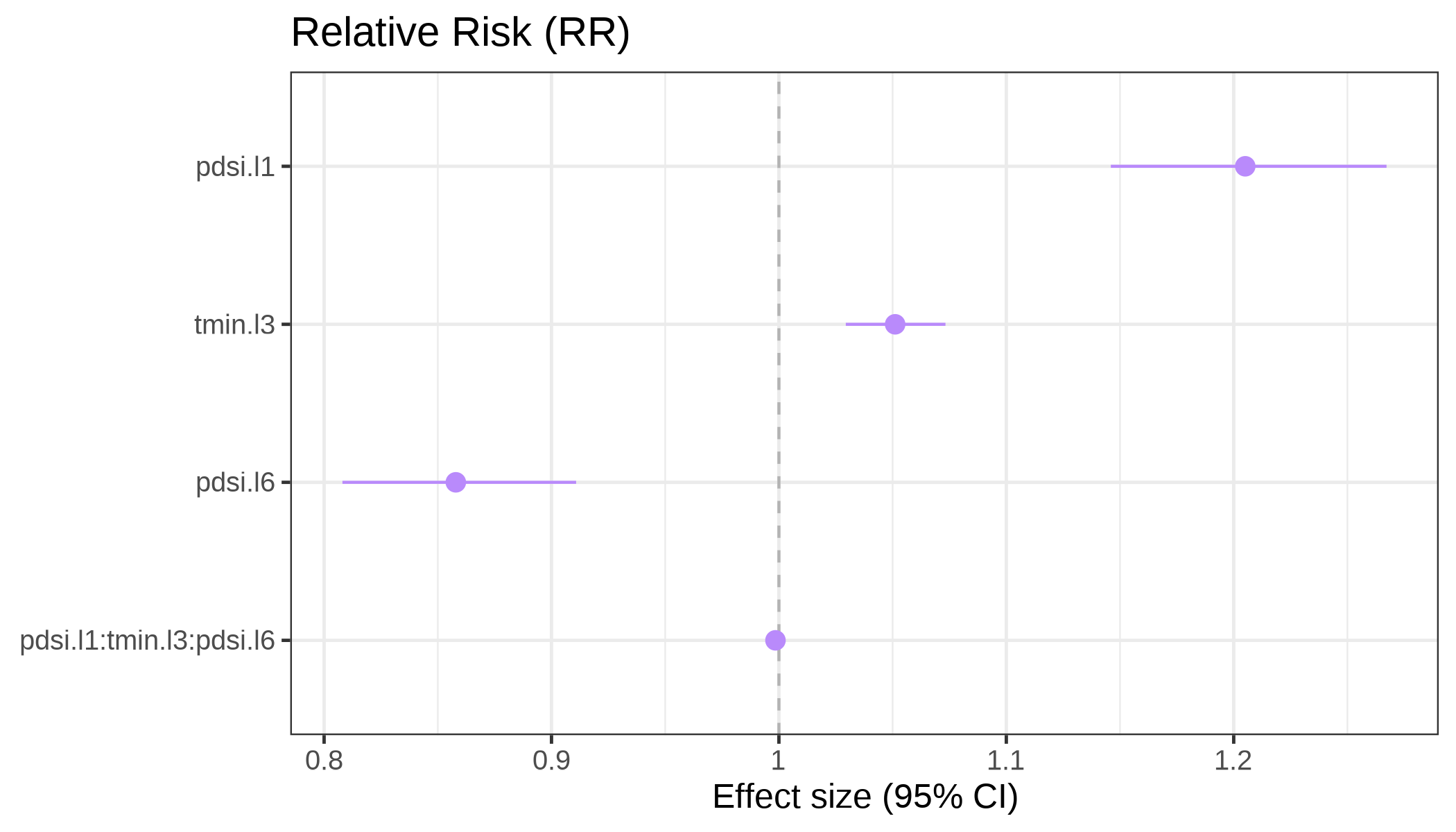




The GHRmodel package supports modeling health outcomes using Bayesian hierarchical spatio-temporal models with complex covariate effects (e.g., linear, non-linear, interactions, distributed lag linear and non-linear models) in the R-INLA framework. It is designed to help users identify key drivers and predictors of disease risk by enabling streamlined model exploration, comparison, and visualization of complex covariate effects.
The image below shows the structure of the GHRmodel package, outlining its functions (in blue), GHRmodel-specific output objects (in purple), generic output objects (in grey), and general functionality. Generic output objects can be provided directly by the user or can be generated using GHRmodel helper functions.

The GHRmodel package is designed to work in tandem with other packages of the GHRtools suite: GHRexplore, which facilitates data exploration and visualization, and GHRpredict, which computes out-of-sample probabilistic predictions of models developed in GHRmodel and enables predictive performance evaluation.
More information about the toolkit, with tutorials and published examples can be found at this website.
The latest version of the GHRmodel package is hosted on CRAN and can by installed using the following commands:
# Install from CRAN
install.packages("GHRmodel")
# Get the development version from Gitlab
library(devtools)
devtools::install_git('https://earth.bsc.es/gitlab/ghr/ghrmodel.git')GHRmodel depends on the INLA package, which is not available on CRAN. Instead, it must be installed from its own repository as follows:
install.packages("INLA",repos=c(getOption("repos"),
INLA="https://inla.r-inla-download.org/R/stable"), dep=TRUE) In case you run into any issues, please check the installation instructions on the R-INLA website.
To fit a model with R-INLA, formulas need to follow its required syntax and structural conventions. INLA-compatible model formulas can be developed using either:
User-defined INLA-compatible input, which may consist of either user-defined covariate lists or user-defined formula lists.
GHRmodel helper functions that allow the user to pre-process and transform covariates and streamline writing INLA-compatible formulas.
In this example the user provides a list of INLA-compatible model
formulas. These are passed to the as_GHRformulas() function
to be converted into a standardized GHRformulas object.
This ensures consistent output structure and random effect specification
across models that can be interpreted by the function
fit_models() for model fitting.
library("GHRmodel")
# Convert list of user-defined INLA formulas into a GHRformulas object
formulas_user_ghr <- as_GHRformulas(c(
# Model 1: random effects only, where monthly random effect is replicated by meso region and the spatial random effect is replicated by year
"dengue_cases ~ 1 +
f(month_id, model = 'rw1', replicate = spat_meso_id, cyclic = TRUE, constr = TRUE, hyper = prior_t) +
f(year_id, model = 'iid', constr = TRUE, hyper = prior_t) +
f(spat_id, model = 'bym2', graph = g, constr = TRUE, hyper = prior_sp, replicate = year_id2)",
# Model 2: random effects and a varying effect for pdsi lag 1 by climate zone
"dengue_cases ~ 1 + f(main_climate_f, pdsi.l1, model = 'iid') +
f(month_id, model = 'rw1', replicate = spat_meso_id, cyclic = TRUE, constr = TRUE, hyper = prior_t) +
f(year_id, model = 'iid', constr = TRUE, hyper = prior_t) +
f(spat_id, model = 'bym2', graph = g, constr = TRUE, hyper = prior_sp, replicate = year_id2)",
# Model 3: random effects and a 3-way interaction between different pdsi and tmin lags
"dengue_cases ~ 1 + pdsi.l1 + tmin.l3 + pdsi.l6 + pdsi.l1:tmin.l3:pdsi.l6 +
f(month_id, model = 'rw1', replicate = spat_meso_id, cyclic = TRUE, constr = TRUE, hyper = prior_t) +
f(year_id, model = 'iid', constr = TRUE, hyper = prior_t) +
f(spat_id, model = 'bym2', graph = g, constr = TRUE, hyper = prior_sp, replicate = year_id2)"
))The fit_models() function allows users to fit a set of
INLA-compatible model formulas defined by a GHRformulas
object to a provided data set. It automates model fitting, extraction of
outputs, and computation of a wide range of goodness-of-fit (GoF)
metrics. The output is a GHRmodels object.
# User-defined INLA-compatible formulas can be passed into fit_models() as a GHRformulas object
model_user <- fit_models(
formulas = formulas_user_ghr,
data = data,
family = "nbinomial", # Negative binomial likelihood
name = "mod", # Label prefix for each model
offset = "population", # Offset variable to account for population size
control_compute = list(
config = FALSE, # Do not posterior predictive distribution
vcov = FALSE # Do not return variance-covariance matrix
),
pb = TRUE, # Display progress bar
nthreads = 8 # Use 8 threads for parallel computation
)For model evaluation, GHRmodel provides a range of
functions for model diagnostics, interpretation and evaluation.
Functions with the prefix plot_* return graphical
ggplot2 or cowplot objects, allowing users to
easily customize visual outputs.
# Plot any linear coefficients found in the fitted model results.
plot_coef_lin(
model = model_user, # Provide fitted model GHRmodels object
exp = TRUE, # Exponentiate coefficients to relative risk scale
title = "Relative Risk (RR)" # Plot title
)
Giovenale
Moirano, PhD

Barcelona Supercomputing Center
Global Health Resilience
Carles Milà,
PhD

Barcelona Supercomputing Center
Global Health Resilience
Anna B.
Kawiecki, PhD

Barcelona Supercomputing Center
Global Health Resilience
Rachel Lowe,
PhD

Barcelona Supercomputing Center
Global Health Resilience (Group leader)